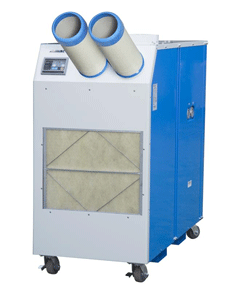Portable Air Conditioner - Spot Coolers
A portable air conditioner, also called "Spot Coolers" is a ac unit on wheels that can be easily transported inside a home or office. They are currently available with capacities of about 6,000 to 60,000 BTU/h (1,800 to 18,000 watts output) and with and without electric resistance heaters. Portable true air conditioners come in two forms, split and hose. Evaporative coolers, sometimes called conditioners, are also portable.
Air-cooled portable air conditioners are compressor-based refrigerant system that use air to exchange heat, in the same way as a car or typical household air conditioner. With this type of system the air is dehumidified as it is cooled. They collect water condensed from the cooled air, and produce hot air which must be vented outside of the cooled area (they transfer heat from the air in the cooled area to air which must be vented).
A split system has an indoor unit on wheels connected to an outdoor unit via flexible pipes, similar to a permanently fixed installed unit.
Hose systems, which can be Air-to-Air and Mono-block, are vented to the outside via air ducts. The "mono-block" version collects the water in a bucket or tray and stops when full. The Air-to-Air version re-evaporates the water and discharges it through the ducted hose, and can run continuously.
 |
|---|
A single-duct unit draws air out of the room to cool its condenser, and then vents it outside. This air is replaced by hot air from outside or other rooms, thus reducing efficiency. Modern units run on approximately 1 to 3 ratio i.e., to produce 3 kW of cooling this will use 1 kW of electricity. A dual-duct unit draws air from outside to cool its condenser instead of from inside the room, and thus is more efficient than most single-duct units.
Evaporative air coolers, sometimes called swamp air conditioners, do not have a compressor or condenser. Liquid water is evaporated on the cooling fins, releasing the vapor into the cooled area. Evaporating water absorbs a significant amount of heat, the latent heat of vaporization, cooling the air—humans and other animals use the same mechanism to cool themselves by sweating. Disadvantages are that unless ambient humidity is low (dry climate) cooling is limited and the cooled air is very humid and can feel clammy. They have the advantage of needing no hoses to vent heat outside the cooled area, making them truly portable; and they are very cheap to install and use less energy than refrigerate air conditioners.